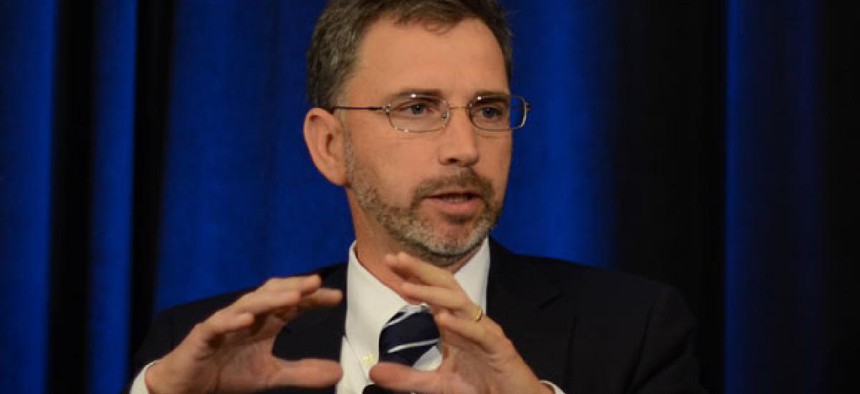
GSA's Dan Tangherlini Caitlin Fairchild/GovExec.com
GSA strives to become the 'civilian DARPA'
Novel office layout and mobile technology boost productivity, Tangherlini says.
As the General Services Administration moves beyond last spring’s scandal over lavish spending at a Las Vegas training conference, it is pursuing innovation in ways that could make it a “civilian [Defense Advanced Research Projects Agency],” acting chief Dan Tangherlini said Thursday.
“A huge amount of innovation comes from the public sector,” Tangherlini told a panel at The George Washington University Trachtenberg School of Public Policy and Public Administration. “The government creates a just environment for private innovation. Just look at the patent system, the judicial system and the New England town hall, which was Facebook before Facebook knew what Facebook was.”
Tangherlini used his keynote speech to highlight GSA’s innovations in office layout, mobile technology and crowd sourcing for new ideas.
At a time of diminishing revenues and no decrease in demand for services, he said, GSA is making “necessity the mother of invention” in finding new ways to get innovations out to the marketplace and “leveraging the scale and scope of the federal government” to strengthen the services it provides other agencies.
Using a comically Photoshopped visual, he likened his agency’s creative process to a lion chasing a giraffe by donning stilts to equalize their heights, followed by an image of a storefront that sells the stilts. “The ability to share is a challenge for the government because we’re not organized for it,” Tangherlini said, pointing to a slide to show the complexity of GSA’s organizational chart.
One way GSA is breaking down barriers, he said, is by emulating the “bullpen” office layout New York City Mayor Michael Bloomberg uses, in which all deputy mayors and top aides sit elbow-to-elbow at desks in a single room. “To make the best decisions, you need information to collaborate and problem-solve as opposed to coordinating schedules and finding your way through the Praetorian guard,” he said. “So you erase the physical boundaries.”
Like his predecessor at GSA headquarters, Martha Johnson, Tangherlini sits not in a traditional executive’s large and protected paneled office, but in a cubicle in shared space, with private rooms available nearby for confidential discussions. “About 30 percent of desks are vacant at a given time, so the question becomes whether we should we take the money from programs to give people a particular piece of real estate, which depends on what an agency does,” he said.
GSA takes full advantage of telecommuting, mobile devices, the cloud and social media to save money and increase productivity while marketing its services such as bulk purchasing and fleet management to other parts of the government, he said.
Ideas for innovations have come from citizens, who can win prize money by submitting to the Challenge.gov website, and from GSA employees, who weighed in with 632 suggestions in the recent Great Ideas Hunt. One saved $1 million through canceling a paper survey that duplicated one from the Office of Personnel Management.
“If GSA gets a certain technology certified, we share it with other agencies since it will take a longer time if everyone has to figure it out,” Tangherlini said. Making a business case for another agency “would be easier,” he added, “if there were more transparency on how agencies actually spend money.”
The advantage of innovating in the public sector, he said, is “we don’t need to own the idea,” in that the taxpayers have already paid for it. The leader’s role is to talk about what exciting things the agency wants to accomplish without pointing out, at least at the outset, the potential constraints, he said: “The barriers force us to be more innovative.”
On the panel to provide a governmentwide view of innovation was Shelley Metzenbaum, associate director for performance and personal management at the Office of Management and Budget. She said President Obama has long been committed to such innovations as moving data to the cloud and cultivating studies in science, technology, engineering and math.
“The evidence from the private and public sector is that stretch goals make a huge difference,” she said, adding that current acting Obama budget director Jeffrey Zients, the first federal chief performance officer, early on required the 24 major agencies to set about five goals that could be achieved within two years and within budgets. Successful examples she cited include the Interior Department’s exponential hike in granting permits on public lands for generating renewable energy, and reductions in crime rates on Indian reservations through improved use of data and interagency collaboration.
DARPA was represented by Jay Schnitzer, director of its Defense Sciences office. He stressed that major scientific discoveries often are interdisciplinary and 90 percent of DARPA’s research and development is through contracts. “They’re all within the Federal Acquisition Regulation,” he said. “All agencies can do what we do.”
Private sector input came from Bruce Chew, global thought leader at the Monitor Group consulting firm. He praised the Veterans Affairs Department’s Blue Button program that puts verterans’ medical records safely on a portable thumb drive. “The private sector made a run at it but failed,” he said. Private companies often approach investments like gambling at a horse race, Chew added. “if your first nine horses fail but the 10th wins, it pays and you’re a hero,” he said. “But if you’re in a federal agency and you have failure nine of 10 times, you’d be in a lot of headlines.”
An advantage of the public sector in innovation, Chew said, is an agency can get the word out that there is a new “opportunity space,” while a business might have to keep it proprietary.
Tangherhlini was asked whether GSA’s approach to innovation was a recruiting asset. Not currently, he said, because he has imposed a hiring freeze. “But a lot of people are interested in the events of six months ago,” he said. “It’s a great conversation starter.”







